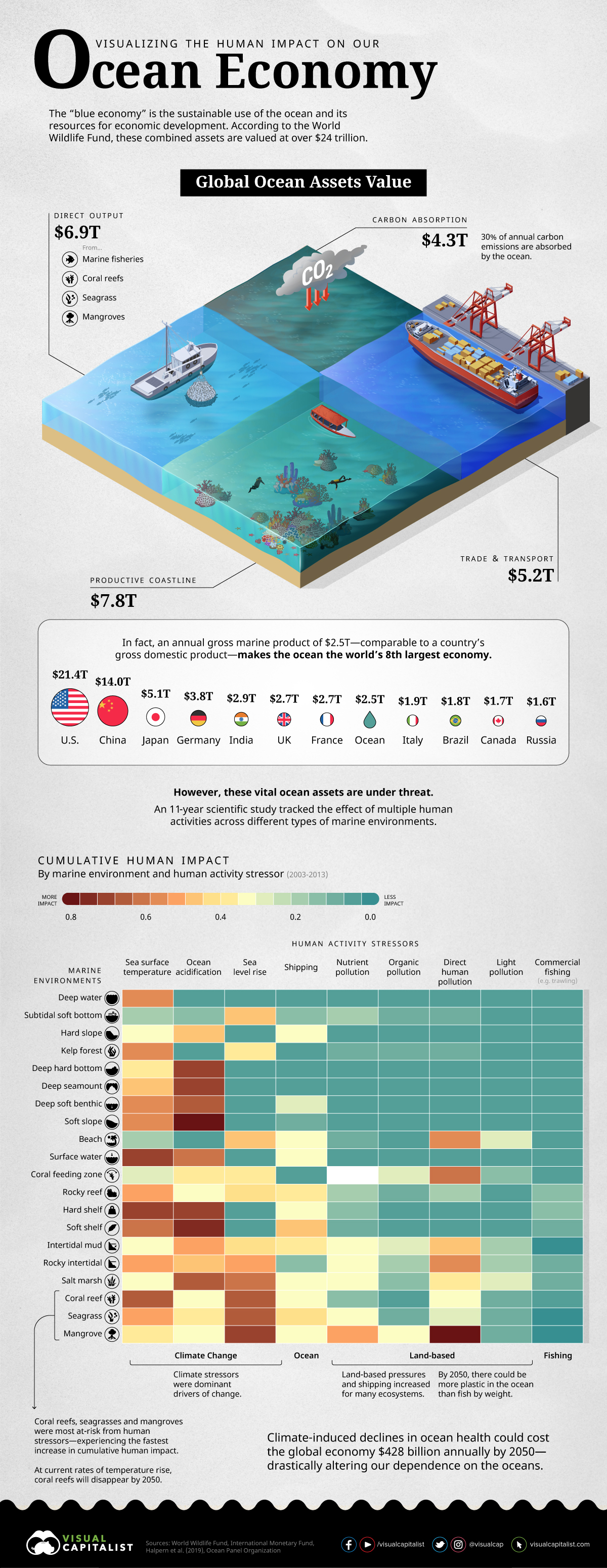From VisualCapitalist by Iman Gosh
When you think of economic output, it’s likely the ocean isn’t the first entity that comes to mind.
But from facilitating international trade to regulating the climate, the “blue economy” contributes significant value in both tangible and intangible ways.
The sustainable use of the ocean and its resources for economic development and livelihoods have such far-reaching effects, that its protection is a significant goal of the United Nations, as well as for many other countries and organizations throughout the world.
However, these vital ocean assets are in danger of sinking quickly.
We look at the total value of assets that come from our ocean, and how various human activities are affecting these resources.
Global Ocean Asset Value
Economic value from all the oceans is measured both by their direct output, as well as any indirect impacts they produce.
According to the World Wildlife Fund, these combined assets are valued at over $24 trillion.
Here’s how they break down:
- Direct Output: Marine fisheries, coral reefs, seagrass, and mangroves
- Total value: $6.9T
- Examples of direct output: Fishing, agriculture
- Trade and Transport: Shipping lanes
- Total value: $5.2T
- Adjacent Assets: Productive coastline, carbon absorption
- Total value: $7.8T, and $4.3T respectively
- Examples of services enabled: Tourism, education/conservation (such as jobs created)
In fact, the annual gross marine product of the oceans is comparable to the Gross Domestic Product (GDP) of countries, coming in at $2.5 trillion per year—making it the world’s eighth largest economy in country terms.
Unfortunately, experts warn that various human activities are endangering these ocean assets and their reliant ecosystems.
The Cumulative Human Impact on Oceans
An 11-year long scientific study tracked the global effect of multiple human activities across diverse marine environments.
The researchers identified four main categories of stressors between 2003-2013.
- Climate change: Sea surface temperature, ocean acidification, and sea level rise
- Ocean: Shipping
- Land-based: Nutrient pollution, organic chemical pollution, direct human pollution, light pollution
- Fishing: Commercial and artisanal fishing, including trawling methods
Across the board, climate stressors were the most dominant drivers of change in a majority of marine environments.
Similarly, pollution levels have also increased for many ecosystems.
Plastic pollution is especially damaging, as it continues to grow at u
nprecedented rates, with a significant amount ending up in the oceans.
The World Economic Forum estimates that by 2050, there could be more plastic in the ocean than fish by weight.
Among the various marine environments, coral reefs, seagrasses, and mangroves proved to be most at-risk, experiencing the fastest increase in cumulative human impact.
However, these are also the same ecosystems that we rely on for their direct economic output.
Overall, climate-induced declines in ocean health could cost the global economy $428 billion annually by 2050.
The Ocean Economy is in Hot Water
It can be difficult to truly understand the scale at which we rely on the ocean for climate regulation.
The ocean is a major “carbon sink”, absorbing nearly 30% of the carbon emitted by human activity.
But acidity levels and rising sea surface temperatures are changing its chemistry, and reducing its ability to dissolve CO₂.
According to the UN, ocean acidification has grown by 26% since pre-industrial times.
At our current rates, it could rise to 100-150% by the end of the century.
Overfishing is another urgent threat that shows no signs of slowing down, with sustainable fish stocks declining from 90% to 66.9% in just over 40 years.
To try and counteract these issues, this year’s virtual World Oceans Day is focused on “Innovation for a Sustainable Oceans” to discuss various solutions, including how the private sector can work with communities to maintain the blue economy.
In addition, there’s a petition in place to urge world leaders to help protect 30% of the natural world by 2030.
Will our human activities continue to stress the ocean economy, or will we be able to positively reverse these trends in the years to come?

No comments:
Post a Comment